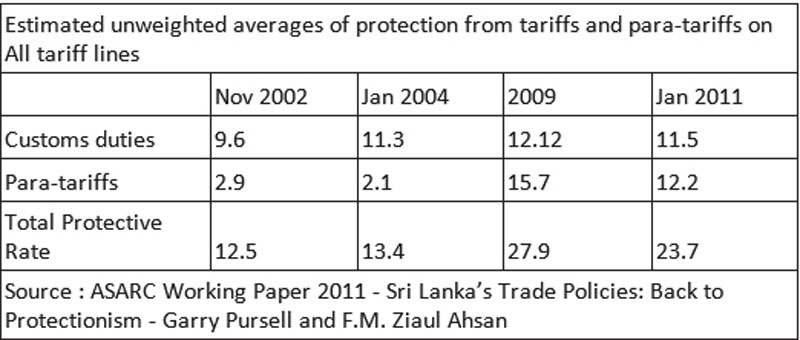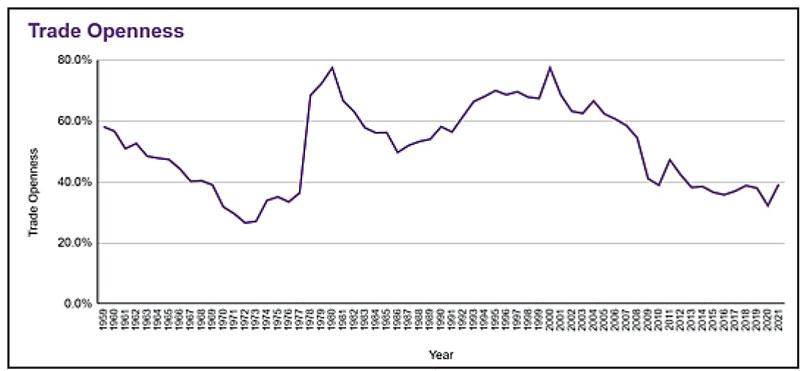Friday Dec 19, 2025
Friday Dec 19, 2025
Friday, 3 February 2023 00:10 - - {{hitsCtrl.values.hits}}


Source : Central Bank of Sri Lanka
 As Sri Lanka is inaugurating its political independence of 75 years on 4 February, the burning issue the public is struggling to grapple with, in the recent past, is the worst economic slump. Many factors have contributed to the current economic crisis but protectionism and trade barriers are main elements that have further depleted the economy, shaping it as uncompetitive and inward-looking.
As Sri Lanka is inaugurating its political independence of 75 years on 4 February, the burning issue the public is struggling to grapple with, in the recent past, is the worst economic slump. Many factors have contributed to the current economic crisis but protectionism and trade barriers are main elements that have further depleted the economy, shaping it as uncompetitive and inward-looking.
Even though Sri Lanka was known as a fairly open economy, the dynamics of trade has changed since 2004. The planned reduction of tariffs into a single band had been abandoned by the end of 1990s. Since about 2005, Sri Lankan trade policy has been characterised by a protectionist approach.
The Government was involved in economic decision making and policies related to import substitution were much more prominent. As highlighted in the Trade Policy Review of Sri Lanka by the World Trade Organisation in 2010, the average tariff protection increased . In fact, it can be noted as frequent and ad hoc changes in tariff structure. The trend in protectionist policies resulted in a fall of exports as depicted by the ratio of exports to GDP .
In 2009, by the time peace was restored, Sri Lanka had nine para tariffs applicable for imports in addition to the standard customs duties, of which , five were ‘para-tariffs’: taxes which are only applied to imports and there is no domestic equivalent. Adding to whatever protection is provided to domestic production by customs duties, with such para tariffs being in place, the protectionism became even more complicated.
A systematic comparison of Sri Lanka’s tariff structure at November 2002, January 2004, 2009 and January 2011 suggests that the total protection rate notably increased between 2004 and 2009 .
The ensuing years were followed by many ad hoc and duty exceptions and case-by-case adjustment of duties on many imports which directly compete with domestic production. By 2015, the average effective rate of protection for manufacturing production had increased by 16%.
This trend is well depicted through the Trade Openness indicator as given in Figure 1. The degree of openness is measured by the actual size of registered imports and exports of an economy. In other words, it suggests how free or restricted a country is in its relations with the rest of the world.
Since 2004 onwards there has been a decline in the trade openness of Sri Lanka and this trend continued up until 2010. By 2015 with an increased rate of protection, the trade openness deteriorated to 36.6%.
Since 2019, Sri Lanka has been pushing many import controls creating disruptions in the market. This tendency resulted in further decline of trade openness 32.2% in 2020. It is similar to the trade openness during 1970 - 1976 when the liberalisation policies were reversed and the economy had high regulations. The trade policy was more aligned towards import substitution.
Trade restrictions
Sri Lankan businesses face a variety of trade restrictions exacerbated by the economic crisis. Accordingly, such conditions that impact the price, quality, quantity, or timeliness of product delivery but are outside the direct control of the exporter or importer.
Both the importing country’s border and the border of the exporting country have been parallelly imposed with restrictions. Even though a number of Free Trade Agreements have reduced external trade barriers and expanded access to markets, Sri Lanka has kept its borders closed by enacting internal trade restrictions.
Internal trade restrictions can be identified in terms of broader categories such as;
1. Monetary and regulatory barriers,
2. Procedural barriers,
3. Service barriers,
4. Technical barriers and
5. Market barriers
Currently a number of monetary and regulatory barriers exert pressure on Sri Lankan businesses, while lowering the country’s competitiveness on international trade. Such barriers include complex tariff structures, quotas, import restrictions, excessive duties or levies and export and import licenses.
Both exporters and importers encounter ineffective, unpredictable, and less transparent procedures throughout the entire trade process. This is mostly the result of poor coordination between agencies and excessive bureaucracy (red tape) among Government employees.
Additionally, the distribution and financial services channels are two areas where existing enterprises face significant service obstacles, which slows down the final stage of clearance. Shedding further light on the obstacles placed, the technological obstacles have a negative impact on the export competitiveness of local enterprises because of their limited technical and financial resources. Besides the market constraints like price controls are a significant obstacle because they are unrealistic in a setting of shifting global markets and fluctuating currencies.
Impact of trade restrictions
Over the years, the country has experienced a number of adverse effects due to trade restrictions. Net economic losses in the wider economy have increased as this restricts competition. Shrinking volumes of exports and imports have negatively affected domestic production. Consumers are left with limited choice of products while they experience increased prices.
Trade restrictions impact the macroeconomy with a fall in employment opportunities mainly due to the deterrents on domestic and foreign investment. Limitations on land, labour and capital have disincentivised investors from competitive export industries to protected industries and inefficient import substitution. Reduction in economic activity has increased the economic woes among people.
Restrictions on trade have put a significant number of businesses in a precarious position. Starting with street vendors, small and medium scale enterprises who depended on imported raw materials to the larger apparel and construction industries; all the businesses are finding it a challenge to continue their business.
Way towards trade freedom
The way to greater freedom of trade is to reformulate the existing monetary policies and laws in order to enhance trade freedom and provide more opportunities for local enterprises to engage in trade. Also in the current context, easing import restrictions and reducing taxes or levies on imports and exports would be crucial. Additionally, it is important to remove unnecessary Government red tape or bureaucracy wherever possible to make customs processes more simple, effective, clear, predictable and timely. This will help to cut down on processing times at the border and make the movement of goods cheaper, faster and more efficient.
Paving way to greater freedom to Trade - the ability to exchange goods and services openly, creates greater opportunities for Sri Lankans to achieve greater economic prosperity. It opens many avenues towards competition, innovation and economies of scale. The beneficiaries of open trade are the Sri Lankan citizens and businesses who will benefit from lower prices and greater choice.
Freedom to trade will ensure the economic freedom by which the fundamental rights of an individual to make their economic decisions will enhance. The true meaning of independence will only be assured through greater economic freedom.
The writer is a Research Assistant at Advocata Institute.